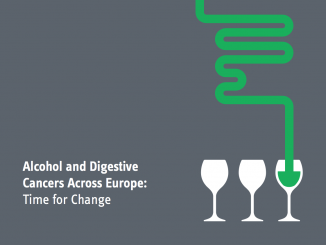In February this year there was a significant announcement from the European Commission – the Joint Research Centre (JRC) launched the European Cancer Information System (ECIS), the result of several years’ work to integrate data from European cancer registries. The ECIS has data from about 150 European population-based cancer registries from 25 EU member states and 7 non-EU European countries.
It comprises an anonymised database of 34.5 million cancer cases at present, excluding non-melanoma skin cancers, and provides a new and visual way of presenting cancer incidence, mortality and survival data. It also has estimates for this year (2018) based on Cancer Incidence in Five Continents for incidence and WHO for mortality in a collaboration led by the International Agency for Research on Cancer (IARC), with also the European Network of Cancer Registries (ENCR) and the International Association of Cancer Registries.
It is the successor to recent projects such as Eurocourse and its European Cancer Observatory, and the JRC says it is designed to be updated quickly. The intention is that there will be an annual call for data from registries to enable comparisons of cancer burdens across Europe using the most up to date information. (The most recent registry data in ECIS is currently from 2014, and the JRC needs to ensure the system is fully operational before the next call for data. Some national datasets date from as far back as 1968).
It has not had much attention, which is not surprising as cancer registries tend not to be the subject of much interest, despite the data often making headlines, mainly to expose poor outcomes in countries such as the UK. But as Anna Gavin, chair of the ENCR, says, the ECIS now provides a mechanism for cancer registries to submit a common dataset for quantifying the burden of cancers, following trends and changes over time. It will also power the Eurocare survival studies, which have been instrumental in influencing policymakers to take action on national cancer outcomes.
Many coutries still have only partial registries
So called “high resolution” studies, such as Eurocare, Rarecare (the rare cancers project), EPIC (the cancer and nutrition study), and a range of childhood cancer studies depend on registries. Cancer registries also of course underpin many aspects of public health and healthcare concerning cancer, from prevention to screening to treatment and its organisation. They continue to play a crucial part in public health policy on tobacco control.

Dr Gavin, who is also director of the Northern Ireland Cancer Registry, notes that “the ECIS does not yet contain data on all of Europe, as some countries do not yet have registries that cover the whole nation. The Netherlands, Nordic countries and the UK are among those that do have complete coverage but not so France and Italy, where there are many regional registries.” For the EU, only about 65% of cancers are currently counted in registries. “A priority for the JRC is to develop a common mechanism for estimating the national cancer burden for countries with partial cancer registration to enable direct and more accurate comparisons between countries,” she adds.
The ECIS depends though on national registries, and one of the missions of ENCR is to provide training and guidelines to enable registries to adopt standard, secure processes that ensure high quality data – Dr Gavin can’t emphasise enough how much work has to be carried out by registries using internationally agreed rules and guidelines to clean and anonymise data before release.
That work, though, needs continued investment. “We see a huge difference in support that registries across Europe receive from their health ministries,” she says.
Ana-Maria Forsea, a dermatologist based in Romania, has taken an interest in cancer registries, spurred by disparities in melanoma registration and data availability for quality of care assessment, which she says echoes the registration inequalities among countries for all cancers. In a 2016 paper, she reviewed the status of population cancer registries in Europe, noting progress but also obstacles as diverse as lack of trained fulltime staff, lack of IT support, variable regulatory frameworks for registry function and data collection, the impact of data privacy regulation, variable monitoring of data quality, and, at the root, lack of funding and political will.
While welcoming European initiatives, including best practice recommendations and the ECRN’s efforts in providing training and tools, she says that “the picture has been slow to change as it is still the case that registries are underfunded and underperforming in some eastern European countries, which are then impeded in their key task of informing cancer control planning decisions.” While population registries should at least provide basic data on incidence and mortality of different cancer types, Forsea says the gaps become larger when it comes to recording and reporting more key factors such as cancer treatment type and timeliness, follow-up and quality of life. “Registries that enjoy adequate funding, stable administrative structure and robust electronic linkages between hospitals and registries that allow automated processes are the best performers, mostly in northern and western Europe.”
Melanoma, adds Forsea, exemplifies cancer inequalities, with wide variation in survival between eastern and western Europe, likely to result from disparities throughout the patient journey, from prevention and diagnosis to treatment access and data registration. Collecting complete and accurate information in registries that can help produce quality indicators for optimising care, and harmonising this collection across countries, is the way forward, as a group of experts including Forsea describe in a recent paper on the EU-MELACARE study, which is run under the European Registration of Cancer (EURECCA) project.
New practices make cancer registries richer and more useful
The paper notes that general population cancer registries tend to be too variable in coverage and data quality for melanoma, and looks more closely at the few population-based melanoma registries that exist, as well as a number of clinical registries (i.e. hospital based). Specialist registries are able to collect many more variables about melanoma cases, and also more early cases from a wider range of sources, as a lot of early melanomas are treated outside of cancer centres. As such, they are able to provide substantially more information for care evaluation, monitoring and planning. For example, the Dutch Melanoma Treatment Registry is tracking how new drugs are working in advanced melanoma.

It is important to learn from models of good practice, says Forsea, such as with Norway’s melanoma registry, which is seen a “blend between a pure clinical registry and a classic national cancer registry”, and indicates the direction of travel for population registries. The Nordic countries are among the most advanced in cancer registry development, and the combination of clinical and population level data is all the more powerful.
As Dr Gavin notes, only population-based registries can provide unbiased information as they cover a defined geographical area for all patients, and so can be used for epidemiological research, to assess screening programmes, follow cohorts of patients and so on. “A hospital registry includes data only on patients treated at the hospital, usually with no defined geographical area. The hospital may treat referrals of more difficult cases and so comparisons of outcomes are not valid unless case mix is taken into account.”
Next steps in registry development can also be seen in the UK, where information on life beyond diagnosis and first treatment for cancer patients is under study , such as patient reported outcome data from men living with prostate cancer (the Life after prostate diagnosis project), and identifying risk of breast cancer recurrences. (See here for details of the N. Ireland cancer registry’s partnership with Macmillan, including the prostate and breast projects, and also this paper by Macmillan – Measuring recurrence, progression and functional outcomes in patients with cancer).
The Cancer Data Dashboard in England is a good example of what can be achieved in presenting a wider dataset, initially in the most common cancers (so far it covers breast, prostate, lung and colorectal, including treatment data on colorectal and lung; quality of life is in development but there are patient experience measures).
The challenge of data linkage in the age of stricter privacy regulations
Dr Gavin notes that there is also a wide range of genomic and biological information that could be linked confidentially to registries, such as HPV status, important in cervical and head and neck cancers. But beyond cancer data there are also opportunities to link registries with other types of information. “For example, we can investigate children with leukaemia to see how they do academically by securely linking anonymised data for analysis.”
Co-morbidities and psychiatric conditions are other medical data that could be linked, to identify groups that require extra support. Biobanks that are collecting information on healthy adults to understand risk factors for disease later in life are another candidate for linkage (see here for a presentation on the UK Biobank and a pilot linkage with England’s National Cancer Data Repository).
Indeed, “data linkages and cancer registries” is the theme of the upcoming ENCR scientific meeting in Copenhagen, notes Dr Gavin. But while new developments are important, the conference also dedicates a whole day to training on data coding, and there’s a workshop on data protection, important given that the EU’s General Data Protection Regulationcame into force on 28 May this year. Getting the basics right and ensuring registries are doing things the same way remains a core mission, such as coding haematological malignancies correctly and putting in the administrative nuts and bolts so that registries can issue timely, clean data under applicable laws.
Another initiative that kicked off this year is the EU’s Innovative Partnership for Action Against Cancer (iPAAC), the successor to EPAAC and CANCON.Work package 7 is on cancer information and registries, and will be piloting integration with clinical and administrative data to derive data on cancer care pathways and costs, and it will also pilot long-term follow-up of survivors and develop more informative epidemiological indicators. The leader is Roberta De Angelis, who is a member of the Eurocare team.
Meanwhile it is important that the role played by registries is more widely publicised, not least among policymakers and politicians. Forsea was a speaker at a European Parliament event hosted by MEP Charles Tannock in May – “Skin cancer registries in Europe: from knowledge to action”, run as an MEPs Against Cancer meeting with the Association of European Cancer Leagues and Euromelanoma. Needless to say, Forsea’s talk was, “Why registration is indispensable for skin cancer control”.






Leave a Reply